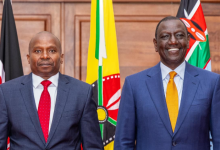President Ruto’s gov’t secures first IMF loan of Sh52.8 billion

The IMF staff has reached a staff-level agreement to disburse $433 million (Sh52.8 billion) to Kenya as part of a $2.34 billion loan approved in May last year.
This is part of the fourth review of Kenya’s economic program under the EFF and ECF arrangements.
“The agreement is subject to the approval of IMF management and the Executive Board in the coming weeks,” IMF’s team led by Mary Goodman and Tobias Rasmussen said in a statement.
According to the international lender, Kenya would have access to SDR 336.54 million (equivalent to about $433 million), bringing the total IMF financial support under these arrangements to about $1,548 million (Sh187 billion).
This latter amount includes the proposed augmentation of access of SDR162.84 million to cover external financing needs resulting from drought and challenging global financing conditions.
The lender termed Kenya’s economy as resilient in the face of a challenging environment.
It has projected the country’s Real GDP to grow 5.3 per cent amid domestic policy tightening and a global slowdown that are likely to also weigh on growth in 2023.
Last year, Kenya’s economy expanded by six per cent supported by robust services sector activity notwithstanding a decline in agricultural output.
“Food insecurity has increased on a severe drought in parts of the country. Higher food and energy prices have pushed up inflation and pressured the external position,” IMF said.
At the same time, the peaceful completion of elections has lifted uncertainty and credit to the private sector. The medium-term outlook remains favorable, supported by proactive reform efforts by the new government.
The medium-term outlook remains favorable, supported by proactive reform efforts by the new government.
“There has been good progress on fiscal adjustment needed to address debt vulnerabilities through pressures remain elevated,” IMF said.
It added that the overall deficit on a cash basis declined from 8.2 per cent of GDP in FY2020/21 to 6.2 per cent of GDP in FY2021/22.
This was supported by strong tax revenue, which increased from 12.6 to 13.7 per cent of GDP.
However, a constrained borrowing environment meant that planned external commercial financing did not materialize.
The lack of funds contributed to 0.7 per cent of GDP in unpaid obligations that were carried over to FY2022/23.
“Significant unbudgeted spending in the early months of this fiscal year, much of it for fuel subsidies, pose an additional challenge.”
To access the loan, Kenya is expected to continue with structural and governance reforms.
This includes completing efforts underway to publish beneficial ownership information for awarded government contracts, which will be a major step towards greater transparency and accountability.
It is also expected to ensure reform of financially-troubled state-owned enterprises—including Kenya Airways and Kenya Power and Lighting.










